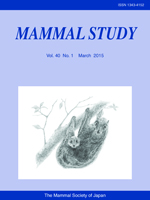To examine the effects of food intake on the gastrointestinal passage time of seeds in the Japanese marten (Martes melampus), we conducted four feeding experiments using captive animals (n = 4). We estimated passage time variables (transit time and mean retention time) of plant seeds (two types) using two different numbers of chicks (single and three) representing two seasons when the animal prey is abundant/scarce. There was no significant relationship between food intake and passage time, and seed type did not affect the passage time variables. Our results were different to those for herbaceous/omnivorous mammals, in which a shorter passage time was observed when food intake increased. The stability in the passage time of the martens could be attributed to the higher level of digestibility of the animal prey. Our data also suggests that martens possess an elastic gut that can expand in volume, which leads to a consistent passage time despite the increase in food intake and enables them to efficiently assimilate nutrients from the consumed food. The results of the present study suggest that the dispersal distance of seeds and defecation site density of martens is influenced by their ranging/activity pattern and not by their digestive physiology.
How to translate text using browser tools
1 March 2015
Effects of Food Intake on Digesta Passage Time in Captive Japanese Martens (Martes melampus) and Implications for Endozoochorous Seed Dispersal
Yamato Tsuji,
Sayako Miura,
Takuya Kotoge,
Toshiaki Shiraishi,
Hitoshi Murai

Mammal Study
Vol. 40 • No. 1
March 2015
Vol. 40 • No. 1
March 2015
amount of prey
endozoochory
Feeding experiment
food intake
Martes melampus




